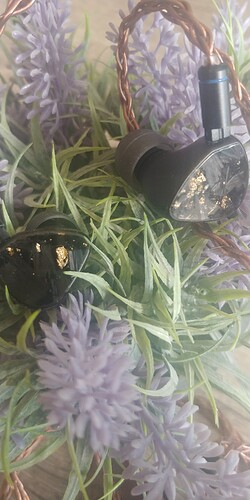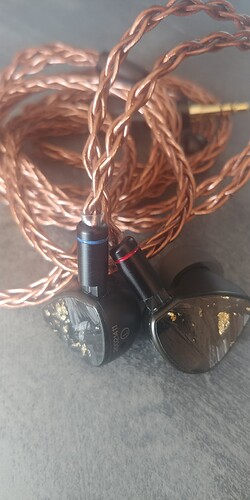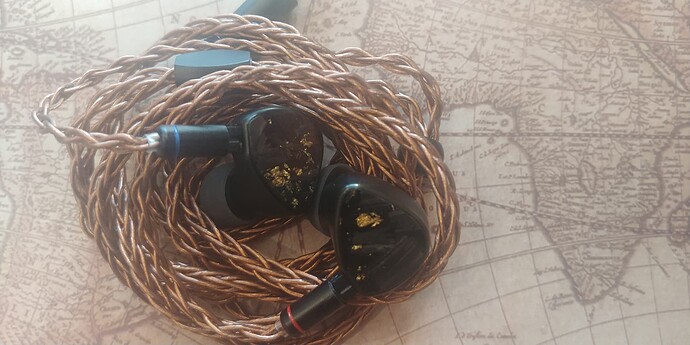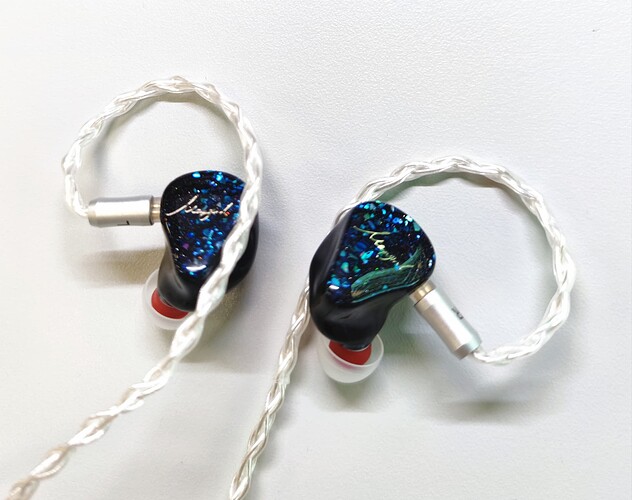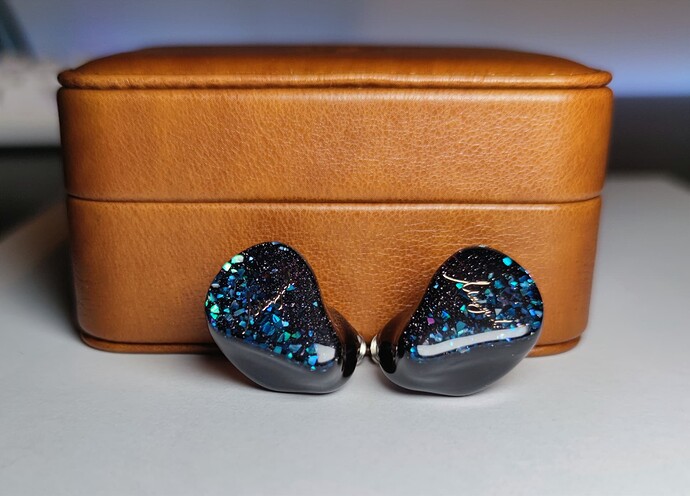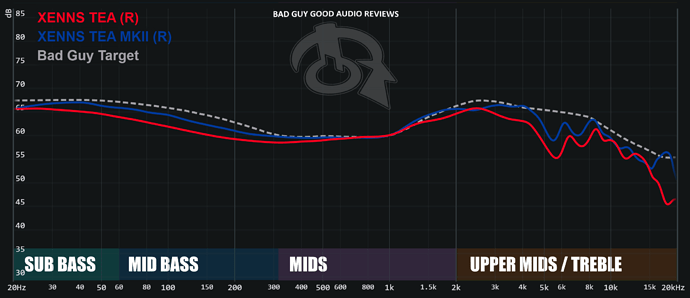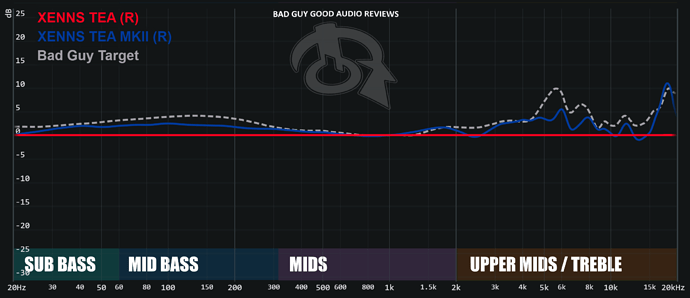Good pairing with Linsoul HC-08 - compacted mids, a little more bass, a little wider sound stage, the same highs, the same resolution. We are slowly turning into Lava 


Dang, I hope the weekend is better for you!
Same stock cable as OG isn’t it?
Yes, it is.
But…but… Olina review 


First came, first served. Olina review will be out before Teas 
Xenns Mangird Tea Mk2 - First Impressions
Disclaimers:
- This unit was sent to me by Linsoul free of charge. There was no incentive given to say anything about this set. The words and thoughts you will be reading are my own.
- I’d like to thank the Linsoul team for sending this, especially in such a short time. I’m eternally grateful for the opportunity given.
- Everyone knows how I feel about Mangird Tea (you might as well just read the title of this thread), but I will try to leave these feelings at the door. What you’ll read from below is not “nymz, the CEO” but Ricardo, a customer just like any of you, but in the role of a reviewer. I don’t have or never had any type of affiliation or monetary benefits regarding Teas. This thread and my journey are a homage to that set, that is still one of my favorites and will most likely keep being. I will be as honest as I possibly can, and the less biased I’m able to, but we are all still human beings.
- This is only a first take, full review will follow in the next weeks, so keep it with a grain of salt.
Price: 350$ (link)
Driver setup: 1DD + 6BA
Context
Anyone that has been around for a while and looked for any IEM around the 300 dollars price range has probably come across Mangird Tea, a balanced and dark hybrid that was somewhat polarizing amongst the crowds. Despite Mangird being somewhat unknown, some folks got their hands on a set of Teas and they were later made well known by a youtube channel called Bad Guy Good Audio Reviews (BGGAR for short). Months passed and Mangird Tea kept gaining some fans, turning into somewhat a cult following.
Tuning wise, Mangird Tea is not a (most) people pleaser, per se. Most won’t hate it, but it’s very balanced and has a dark treble. That is one of the reasons a lot of people love it as well. Despite its confusing graph, Teas are like sleepers, and every frequency just shows when it’s called. It’s the definition of an all-rounder that combines everything into one, no matter what you throw at it. It clearly showed their tuner is smart, keeping everything at a balanced that would strike as something else than it looks like: BA timbre hidden due to treble recession, mid-bass slam despite looking bass anemic, sub-bass greatness even though it’s not that elevated, etc.
This type of tuning also helps with the perception of its real technicalities: Good stage, great imaging, very dynamic, coherent, great separation and resolving for the price, carrying its weight and punching above its own tag.
Months later Mangird changed its name to Xenns and introduced UP to the world: A tribrid with a beryllium coated DD and a warmer graph - promising upgrade, right?
As human nature is made of expectations, everyone expected a Mangird Tea V2, but with ESTs and even better techs and tuning. As with most things in life, expectations turned into deceptions despite UP’s performance, mostly because people were expecting something else.
I was one of the lucky to have heard both. Xenns UP is a different breed and one of those IEMs that is very hard to describe. It’s the warmest set I’ve heard to date, but despite that, Mangird brilliance strikes up again and once it striked me, I couldn’t unsee it: They used beryllium coated drivers to still push some sense of tactile punch into the bass, making it kick like a mule above all the warmth displayed. This trick was also applied to the treble, but by using ESTs drivers - treble could still be slightly boosted, picking up detail and giving it air for its presentation.
You can now see how expectation felt short: from a balanced and semi-accurate replay into a colored replay was a huge road to cross, and people weren’t all that excited for that.
The present
Later this January, out of nowhere, a new product was announced with a mouth full name: Xenns Mangird Tea Mk2.
Hype was back. A successor arrived, looking great outside, but what about the performance? Let’s find out.
Tuning-wise, Mk2 seems to have picked up on customers feedback: A slight boost on bass and treble, but to still keep its full identity. Drivers seem to change a bit on models but also on crossover - Marketing propaganda tells us that the BA to DD crossover was retracted to around lower mid-bass, a phenomena already seen on other IEMs like monarch, where BA’s pick it up earlier to help the DD focus more on sub-bass only, giving it more strength and texture. And oh boy, does it work.
First thing that came to my attention was the bass. Way more prominent and with better authority, increasing the slam OGs had, just taking it into the next level. The DD seems better responsive and textured, keeping at least the same extension if not better.
All of this comes without affecting mids, which, as a mid-head, I appreciate. Regarding elevation, they seem equal around sub-bass but there’s a noticeable difference on mid-bass and overall perception of the zone. This was obvious as soon as I spined tracks like Kindness - House or Trentemoller - Chameleon on both.
I already mentioned mids, but let’s foray into that. The fundamental harmonics will feel the same tuning wise, but the layering/separation and detail will dismiss the draw (Hania Rani - Glass/Esja). A proof that Mk2 technicalities are half step ahead. As for pure vocals, I would say female vocals kept basically the same presentation (Agnes Obel - Curse, Fleetwood Mac - Landslide), just a tad warmer, but male vocals diverse: due to the bass elevation, male vocals (Michael Bublé - Feeling Good, Harry Styles - Falling) will have better presentation and more thickness, without becoming too thick and overbearing, adding to the wanted natural feel of the set.
The trend flows into the treble: due to the bass compensation, the elevation on the treble feels close (Joe Satriani - Crowd Chant, Twice - Moonlight). After a sweep, it seems 8k is less prominent as well but that’s hard to gauge on graphs as well.
To point out that the treble detail and extension are better on Mk2, probably helped by implementation and technicalities.
Technicalities have been spoken all across, but I will wrap them up here:
- Stage depth (Yosi Horikawa - Crossing) and height (Agnes Obel - Curse) are more extended on Mk2. Width feels about the same. Keep in mind that stage was already great to start with, on the OG version;
- Imaging was kept the same: Great;
- Detail level is better overall, and come out as more resolving as well;
- Separation and layering were also improved;
- Dynamics, that were already good and a reason why so many metalheads liked the set, seem to be the same or a hair better, so there’s that.
Before I wrap it up, I’d like to briefly speak about the track presentation. I’d say both are close, but the new version takes half a step to meet UP in a 1/4th of the way, but keeping the vocalists right in front of your face, which seems to help busy tracks or genres like jazz or orchestral music, which I delve into.
The conclusions
There’s no doubt in my head that the Xenns Mangird Tea Mk2 is an upgrade to the Mangird Tea. If the originals had my hard recommendation, Mk2 will have it even more. This new version feels to me, closer to what I would liked for Xenns UP to be: A tribid Mangird Tea with slight touches - And Mk2 gave me some of that.
Now, there’s a topic that I haven’t touched yet, but that is relevant: price.
After hearing both, do I agree with the Mk2 being slightly more expensive? Yes. 50 bucks more? Maybe, I’m not a retailer.
But is it worth having both? I would have to say that it depends on your pockets and current collection. If you have none, get the Mk2. If you already have the OG and love it, keep it that way, if money is tight. If you have the OG and feel it could have more something? Get Mk2.
As for now, with my own tastes and library, value score: 5/5. Placeholder mark: At least A+.
Thanks for reading, full review to follow. Buy Teas.
Best,
nymz, the happy kid
CEO of Tea2 Cult
Thank you for posting your thoughts. Very thorough for first impressions 
Your answer to this question may very well determine which Tea I’ll go for: I like my Timeless, but can often find the mid bass to make it feel a little too “thick”, with sub-bass not being very impactful. Will the Tea2 sound too similar in that regard? (Graphs look pretty close in bass).
I like how the OG Tea graphs bass-wise, but am slightly worried the 5k dip will sound too exaggerated. In the same breath, BGGAR, in his review, said the vocals on the Tea2 are energetic, despite the upper-mid recessions.
Which would you go for in this instance. I know the call is ultimately on me, but would love to hear your thoughts.
Thanks.
Vocals are very energetic, present and natural on both.
If you want reduced mid-bass, OGs. I have to mention that they will feel different since DD vs Planar (especially on texture and impact). Keep in mind graphs lie and I don’t feel Mk2 bass as present into the mids as Timeless was. Both have more sub-bass impact than Timeless.
Mid-bass difference between Timeless and Tea2 is definitely more pronounced on this graph compared to HBB’s.
I’m inclined to think the mk2 is the safer option. You wouldn’t say either is shouty would you?
I find the Aria to be a little shouty. Read in another thread that you’re not a fan of it. Is that for similar reasons?
I don’t like aria for a number of reasons. Neither are southy to me. But vocals are forward (which I love).
Timeless is a planar. Planars take EQ like champs. Play with it, find your mojo, see what you prefer!
I’ll give that a shot before pulling the trigger then. Thanks a ton for your input 
Np, anytime! 
And welcome to the cult 
Very curious to how the Tea2’s compare to the Softear Volume and Olina. Might grab the Volume for that Variations tuning and detail… based off Tony’s review the Volume seems like a Variation with more mid-bass 
I made an assumption that Volume would be B2. I’m almost right - Volume is Variations with a little more mid bass, and this is similar to B2 ( without including all the technical parameters and the difference in price with Variations). I think the Volume will be halfway between B2 OG and B2 Crin. This looks good, as long as there is not much retention on mids.
The Tea party continues with renewed vigor  . Everything is as expected - they listened to the feedback of clients and improved the OG.
. Everything is as expected - they listened to the feedback of clients and improved the OG.
Some people still ask if Tea 2 will be screaming - it can’t be screaming and can’t be compared to Aria and other budget DDs, Chinese tuning of budget kits is always a bit screaming to give a little resolution (with a few exceptions).
I got up early to read the Director’s first impressions and now I’m starting to work again  ! We will be waiting for the full review … Enjoy music and life
! We will be waiting for the full review … Enjoy music and life  .
.
Thanks for the great impression, as always.
I’m getting more and more convinced.
Will you compare Tea2 in your review to Olina/Oxygen? I’m curious to know if they are complimentary or of Tea2 is an upgrade.
I will let you guys know what’s my opinion, once I get it 
Thanks  you too!
you too!
